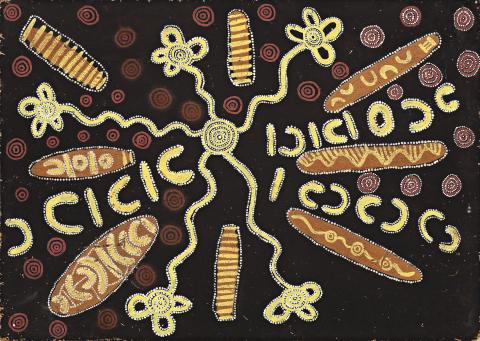WOMAN'S DREAMING, 1972
TOMMY LOWRY TJAPALTJARRI
synthetic polymer powder paint on board
46.5 x 65.0 cm
bears inscription verso: 14008
Painted at Papunya in 1972
Stuart Art Centre, Alice Springs (label attached verso, consignment 14, painting 8)
Private collection
Sotheby's, Melbourne, 30 June 1997, lot 211
Private collection, Sydney
Sotheby's, Melbourne, 31 July 2006, lot 78
The Luczo Family Collection, USA
Bardon, G., and Bardon, J., Papunya, A Place Made After the Story: The Beginnings of the Western Desert Painting Movement, The Miegunyah Press, Melbourne, 2004, painting 317, p. 367 (illus.) together with illustration of the original field notes and diagram by Geoffrey Bardon
Originally a carver of wooden objects, Tommy Lowry Tjapaltjarri joined the first group of painters at Papunya in 1971 when Geoffrey Bardon encouraged the senior men to paint in European materials – thus leading to the formation of the cooperative Papunya Tula Artists. The main subject of Tjapaltjarri’s paintings are the Tingari ancestors, particularly in the guise of two Great Snakes in his customary lands country around Patjarr in the Gibson Desert in Western Australia – one of the most remote locations in the continent. Lowry’s early paintings refer to ceremony and the associated objects – for example, his earliest recorded painting from 1971, Three Corroboree Poles, in the Wilkerson Collection depicts ceremonial poles.1 Dating from the same period, Woman's Dreaming, 1972, depicts a ceremonial scene featuring eight decorated dancing boards that are carried by women in the ritual. The central roundel represents a waterhole from which rivulets stream to other ritual camps, while several red roundels represent campfires, indicating that this was a large ceremonial gathering.2 The women are symbolised by U-shapes adjacent to their coolamon that lie in front of them.
WALLY CARUANA
1. See in Benjamin, R and Weislogel, A.C. (eds.), Icons of the Desert: Early Aboriginal Paintings from Papunya, Herbert F. Johnson Museum of Art, Cornell University, New York, 2009, p. 80
2. Bardon, G. and Bardon, J., Papunya, A Place Made After the Story: The Beginnings of the Western Desert Painting Movement, The Miegunyah Press, Melbourne, 2004, p. 367
